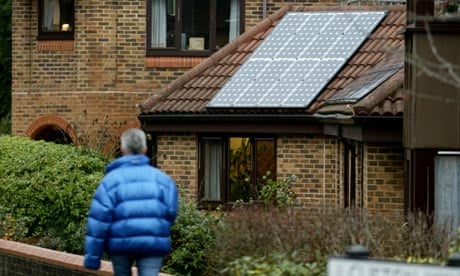Householders tempted by a rash of new "solar for free" offers could double their financial savings by paying for the panels themselves, experts have warned.
The advice comes as installations of solar photovoltaic panels have exploded in the UK, with the number installed in four months in 2010 more than doubling on the whole of 2009 since a government financial incentive was launched in April.
Spurred by the new feed-in tariff scheme that pays small scale generators of green electricity, a glut of companies are offering to fit thousands of homes with solar panels for free. Under the "rent your roof" model, the companies earn the tariff worth approximately £835 a year and the homeowner benefits from an annual saving of around £110 off their electricity bill. Homesun, ISIS Solar and A Shade Greener are three of the firms planning to do a deal with more than 120,000 homeowners by 2015, with Homesun promising to fit 2,000 homes in the next 12 months.
But homeowners would almost certainly be better off paying for the solar panels themselves, even taking into account interest on a loan for the upfront cost of around £10,000 for a typical home. "Looking at the figures, it [paying for panels yourself] looks like a better deal on paper," Liz Laine, energy expert at Consumer Focus, told the Guardian. She added that consumers should go into such deals "with their eyes open". Simon Osborn, policy advisor at Which?, said: "If you have the means to pay for solar panels yourself, then you may well be better off arranging to have them installed yourself." Consumer Focus has also published a checklist of 24 questions people should ask before signing up, including who has liability if something goes wrong with the panels.
Under the "free solar" model, a homeowner would save in the region of £2,750 on energy bills over 25 years, the length of the tariff offer. By paying for their own panels with a loan at 7.7% interest repaid over 10 years and earning income from the feed-in tariff, they could save around £6,506 over the same period.
But the rise of such business models is exactly what the tariff was designed to do, say government and solar industry figures – drive innovation and solar take-up. Since the tariff started on 1 April, 12.12 megawatt peak (MWp) of solar panels have been installed at 4,822 homes, up from 3.8MWp in 2007, 4.42 MWp in 2008 and 5 MWp in 2009. Solar panel makers are responding to the demand, with Sharp announcing it will double annual production at its UK plant to 500 MW in December. The Wrexham plant, which currently employs 750 people, has seen the UK's share of its output rise from 1% to 10%.
"A large number of companies are setting up to do PV [solar photovoltaic panels]," said Ray Noble, solar specialist at the Renewable Energy Association (REA). "Things are moving from a cottage industry to building scale industry, and creating a high number of jobs too."
One UK solar energy company, SolarCentury, has seen its direct employees and network of installers rise from 200 staff in January to 350 now and predicts it will employ more than 500 by 2011.
The tariffs for solar and other renewable "microgeneration" are a key part of the UK's plan to cut carbon emissions and hit an EU target of generating a fifth of energy from renewable sources by 2020. The government forecasts installations driven by the tariff will account for 1.6% of the UK's electricity consumption in 10 years' time.
However, the bill for the government and the taxpayer is unlimited. The government predicts the cost will be around £8 on every energy bill by 2020, though there is no cap and the scheme could potentially be a victim of its own success. Spain last week announced it was slashing its feed-in tariffs for solar PV panels by up to 45%, which some experts believe was a result of the tariff being set too high initially.
The rate of the UK tariff, currently set at 41.3p per KWh for solar PV on existing properties, is fixed until 31 March 2012, when it will be reviewed before decreasing each year. There is disagreement between industry figures over whether the current solar gold rush could force an earlier review. "I think the rate of uptake will be so fast the government will have to do an emergency review (of the rates) or possibly suspend them," Alistair Roberts, project manager at energy co-op Renew, recently told the ENDS Report. "I don't think there's a risk of an emergency review in the next two years, as government needs as much help as possible to hit carbon targets," said Noble at the REA.
Solar is currently the most expensive form of renewable electricity per unit of energy produced, though some in the UK solar industry believe rising energy prices and falling production costs will help it match fossil fuel prices by 2013.

Comments (…)
Sign in or create your Guardian account to join the discussion